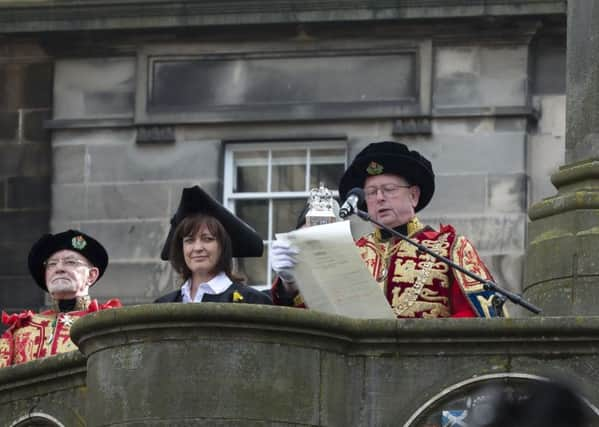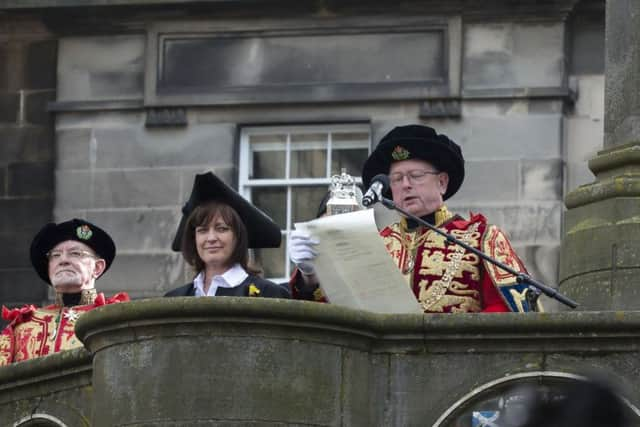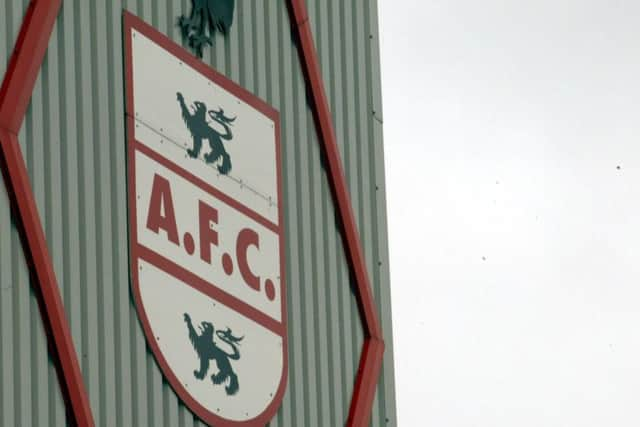Call to arms over threat to Scottish club badges


During my time at University, the Lord Lyon King of Arms was a footnote in a criminal law textbook; I parked the knowledge that he was in charge of heraldry and moved on under the assumption that was unlikely to come up in an exam.
He is more commonly seen on ceremonial duty when he appears with his officers at arms who bear the titles Rothesay Herald, Snawdoun Herald and Marchmont Herald, Ormond Pursuivant, Dingwall Pursuivant and Unicorn Pursuivant, all resplendent in royal standard tabard and velvet. Like a medieval squad photograph revealing a garish away kit, this group may seem unlikely foes.
Advertisement
Hide AdAdvertisement
Hide AdBut they are capable of inflicting defeats on the world of Scottish football.


In July last year, Airdrieonians Football Club received a letter from the Lord Lyon’s Procurator Fiscal (who is responsible for enforcing heraldic law in Scotland) informing the club that its badge – a shield with a couple of lions on it and a cockerel above – had been deemed to be “an heraldic device”. This was the start of a chain of correspondence which ultimately required the club to sign an irrevocable undertaking that it would cease to use its badge from 1 September 2015.
But this issue is not just about Airdrie. The ruling that this League 1 club has had to comply with also applies to the vast majority of Scotland’s senior football clubs, as well as countless rugby clubs, golf clubs, schools and other such organisations.
What constitutes “an heraldic device” is solely a matter for the Lord Lyon’s office but, in correspondence with them, it has been confirmed that framing a club’s badge or emblem within a simple shield is sufficient to enter the world of heraldry. To further confuse matters, a shield does not require to be “shield shaped”; any enclosed shape will do whether circular, diamond, heart shaped etc.
In Scotland, no person or organisation can use “an heraldic device” unless it is contained within the Register of all Arms and Bearings which is maintained by the Lord Lyon’s Office. It is for the Lord Lyon solely to decide whether or not to grant you arms and there are a number of heraldic rules which must be followed. The rules are not written down anywhere but from what I can gather:


1. The first rule of heraldry club is… you cannot use a crown (ask Hibernian FC). That symbol may suggest a connection with the monarchy.
2. A Lion Rampant should be used with great care (ask Rangers and Dundee United). That may clash with the Queen’s own Scottish standard which, in turn, you cannot use without permission.
3. You cannot use a “castellation” or in plain English bricks which look like a castle turret above a shield (ask St Mirren) as that is used to reflect whether a place is a town, city, district, etc.
Advertisement
Hide AdAdvertisement
Hide Ad4. You cannot use a Saltire (ask Formartine United). Its incorporation within arms is strictly regulated as it would suggest national approval.
5. You cannot replicate your town’s coat of arms (ask Aberdeen and Kilmarnock). To use anyone else’s registered arms is forbidden.
6. You cannot use letters (take note Airdrie). Heraldry is about describing who someone is without using letters or numbers.
7. There is a limited range of colours that you can use.
If you break any of the rules, your arms will not be entered on the register. There is no right of appeal. Standards must be maintained.
If that sounds like something from a Monty Python sketch, try reading the Lord Lyon King of Arms act from 1592 under which the power to prosecute is given. Written in old Scots it empowers the Lord Lyon “to put inhibition to all the commoun sort of people nought worthie by be the law of armes to beir ony signes armoralis” i.e. to keep the commoners in their place.
Although the Lord Lyon has his own Procurator Fiscal, there is no “heraldic police force” searching out offenders. Rather, the Lord Lyon’s Procurator Fiscal only takes action where a matter is brought to his attention. In the case of Airdrieonians an application was made to the UK intellectual property office to trademark the badge (by a party other than the club). But Highland League club Formartine United was victim of an anonymous tip-off made to the Lord Lyon’s office and hey presto, Formartine United’s badge was deemed to be “an heraldic device”. It contained a saltire and so could not be registered.
There are many football clubs in Scotland in a similar situation; most of them have not been “in trouble” (yet) simply because they have not been reported. If this was to happen, what would the dreaded letter mean for them?
It would be an option to fight the matter in the Lyon Court but the law is clear and historic use is no defence.
Advertisement
Hide AdAdvertisement
Hide AdIn response to our own situation at Airdrie, an underground movement called the Airdrieonians Tattooed Resistance has been formed and within the last fortnight 11 committed individuals have been added to the ranks.
Another option would be to apply to the Lyon Court for registration. The cost to register a basic shield is £2,500, and if your request is successful, you are provided with your new badge hand painted on calfskin vellum and the Lord Lyon will protect you in the event that anyone else seeks to use it.
With the Airdrie chairman announcing that financing a playing budget next season will be a challenge, it would be an option for our supporters’ trust to seek to raise that sum, but we would rather focus on community initiatives such as free season tickets for kids which we funded to the tune of £9,000 last year.
Finally, a club could adopt a non-heraldic badge. That would have no cost and may involve removing the shield or adopting a simple circular corporate logo as has become commonplace. Gone is the uniqueness, tradition and goodwill value within the local community associated with the old badge.
The Lord Lyon has no jurisdiction in England, and the equivalent office south of the border has not requested clubs to register their badges. Many English football clubs therefore simply register their badges as a trade mark. No calf or any other animal is harmed in the process, and the cost is only circa £150. If that is sufficient to protect Manchester United and Arsenal, I see no reason why the same approach would not work for Albion Rovers and Montrose.
For arms relating to the monarchy, military, individuals and civic entities I can understand the involvement of the Lord Lyon. For corporate bodies and community groups, I would argue that the trademark regime would be more adequate.
There are also those in society who follow our national game. I would suggest that we are far greater in number, but change will only occur if “the commoun sort of people” come together and make their voices heard. If your football club is not affected, there will be a golf club, bowling club or school close to you that is.
Together with Supporters Direct, a change.org petition has been set up in order to demonstrate public support for change and I would ask that you show your support for the cause.
Advertisement
Hide AdAdvertisement
Hide AdThe petition can be found at https://www.change.org/p/scottish-parliament-recognise-and-protect-the-community-value-of-club-badges?just_created=true and further details of the campaign are available at www.savethebadge.co.uk.
• Colin Telford is a member of the committee of the Airdrieonians Supporters’ Trust and a solicitor.
FOLLOW US
SCOTSMAN TABLET AND MOBILE APPS